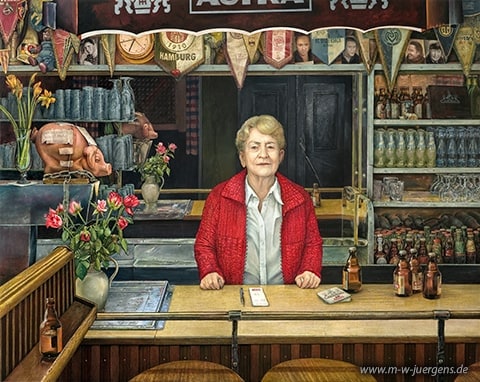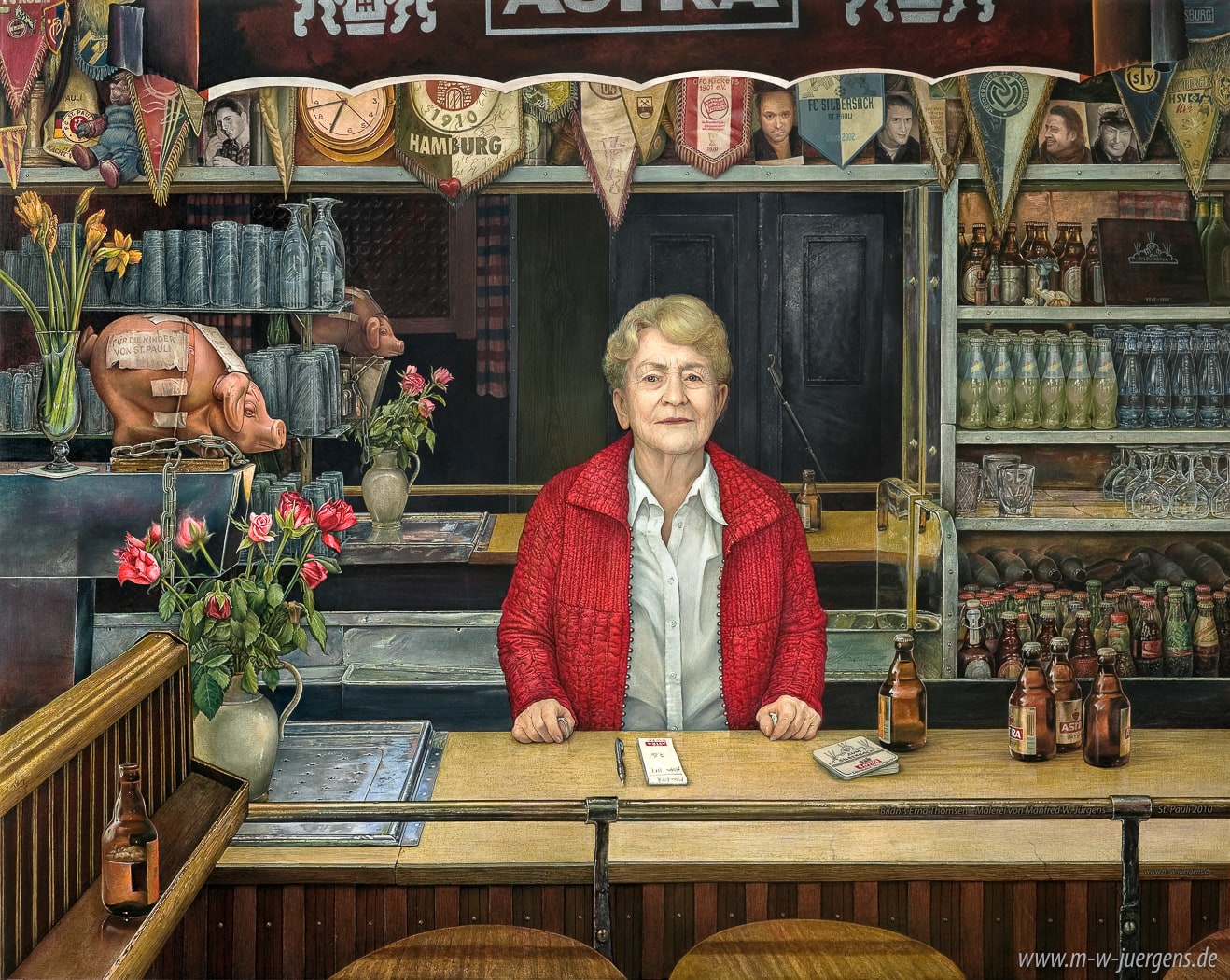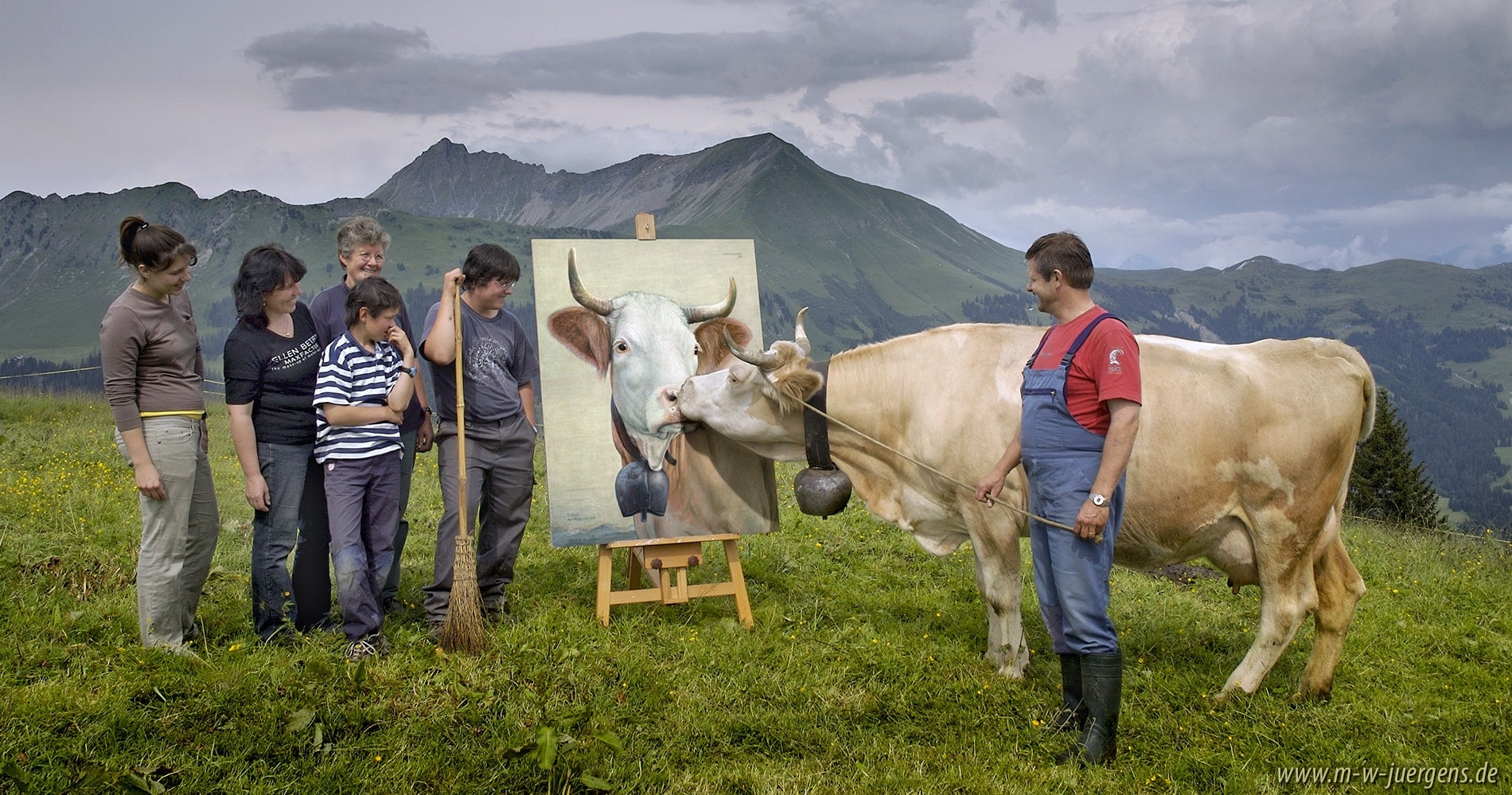

To begin with, a confession: I love strong women. A long story is part of a woman's long life. Even as a teenager I liked to visit Aunt Lotti a few villages away in Drispeth in Mecklenburg. Drinking beer with friends in the pub of this elderly lady in a rustic living room atmosphere was something of a cult. Three generations celebrated there and told their stories. I would have loved to paint Lotti back then. But the little landlady, for whom we had great respect, did not want to be portrayed.
In 2002 I celebrated for the first time in the Hamburger Silbersack on St. Pauli. Since then, the pub has brought me good luck. Over the years I got to know interesting people from all social classes. Petty and big criminals, actors, politicians, musicians, whores, theater directors, pastors, bankers, posers, desperate people, seekers, light and heavy drinkers, helpless and unstable, innkeepers and confused, losers and optimists, rose and newspaper sellers.
My later Venice exhibition was arranged here in 2004. And here at the bar the idea flowed into me to portray the landlady Erna Thomsen.
On the blissful way home after a visit to Silbersack, I said to my wife: 'Did you look the boss in the eye while saying goodbye? This lady would have to be painted. Including her universe called Silbersack.' 'I beg your pardon?' she replied. 'All the pennants and bottles too?' 'Yes, yes! ‘I got the impression: Somebody saved her time for us. I still have great respect for such consistency.
In 2007 we moved to Hamburg. Like me, this St. Pauli was full of contradictions. The unadorned, curious look into the abyss fascinated me. The devil knows why I want to look him in the eye from time to time. Is it the insatiable curiosity about life?
In the Brockhaus Conversations Lexicon from 1884 I read: 'There were inns and taverns in the modern sense in large numbers in ancient times. For the most part, these smoky and, as Horace says, 'greasy rooms' were intended for the lowest class of the population, who restored, quaffed, danced and told news here without much comfort. But there were also taverns in which more refined pleasures captivated noble people and in which one could gamble away a fortune, especially with game of chance and women.'
Now we lived in a loft on the Hotel Hanseport parallel to the Herbertstrasse. Helmut, the host of the pub on the corner, told me with a smile while looking at my studio window: It used to be busier up there. A very enterprising, beautiful noble whore worked there.
When my wife first looked out the window of our new apartment into the narrow alley of the Erichstrasse, she said: 'Déjà-vu: I know that look.' She went to the bookshelf and pulled out a small illustrated book. A present from days gone by. Women on St. Pauli, a 1970s documentary in black and white.
Days later we showed the book at the bar across the street. An old whore, who was still active at the age of 76, recognized many of the ladies of yore. Her gaze floated into infinity: Well, my suitors grew old with me. A wistful smile spread across her face.
We regularly celebrated our way through the nightly neighborhood and tried to understand and appreciate the new life. Even the dirty can develop its charm. In wondrous, sometimes lovingly rocked taverns and grottos, bar ladies, bartenders and whores became confidants and sometimes even friends.
We visited theaters in Hamburg before we even lived there. My wife and I often stayed in the hour hotel across the street from the St. Pauli Theater. Big cinema in front of and in the theater. What an interesting and absurd experience. St. Pauli became a place of longing.
When Ulrich Tukur and his band performed in the St. Pauli Theater, Hamburg's oldest landlady, Erna Thomsen, often sat in the front row. Ulrich invited her regularly and his final moderation of the concerts often ended with the words: 'See you later in one of the most remarkable establishments in this city, in Erna's Silbersack.'
Solid prices: beer for 1.90 euros a bottle was once read outside in the shop window. On the poster a sparingly dressed young lady with the caption: Please also note the beer! Happy footballers next door. On the pitch, ’Erna's Boys’, a lively recreational football team with the great name ’FC Silbersack’, represented the pub. Inside, on the tables, there were old juice bottles with fresh flowers every day. There I saw the first bar with a railing. One got the impression that every German soccer team had donated at least one club pennant for the mirror shelves behind the counter. Odds and ends and postcards, including by Hans Albers and Freddy Quinn, also adorned the shelves.
And Erna? Erna didn't come, she appeared. Always wore red, pope red, was at the same time captain and grande dame on her ship called Silbersack, which she safely guided through the ups and downs of her decades.
A lot worked through non-verbal communication. She was charming, warm and strict at the same time. A little woman to look up to. Erna, the soul of this St. Pauli bar. With regard to the red light, she said to me, 'Yes, to be there, but not to participate.' 'I haven't had a beer in my entire life. That's too bitter for me. Occasionally a glass of sparkling wine, a little egg liqueur or a glass of champagne.'
Erna was happy when there was a party, because if you celebrate, you drink, and that's good for business. No matter if student, businessman, actor or sex tourist.
Business had to go! It boomed in the 50s and 60s. ’Luett and Luett’, 0.1 l of beer and a caraway schnapps, for 45 pfennigs were a hit. Lipsticks, tights, condoms and porno magazines were sold in the toilet rooms.
The 70s were more difficult, the pent-up demand was covered. There was less drinking outside the home. Family fathers saved up for a small car and the long-awaited vacation in Italy. All of a sudden, salaries were no longer in wage packets, but transferred to the bank account, so it was much safer from dropping into the Silbersack. Fishing zones were set up, and Hamburg shipping companies also gave up. Seafarers became unemployed and Erna's turnover fell noticeably. She said: It was bitter. I even had to fire employees.
I was fascinated by this strong little woman. She reminded me of Aunt Lotti from Drispeth. On my own, I asked quietly: Ms. Thomsen, I would like to paint you. Her answer was: 'Now don't always tell Ms. Thomsen. I'm Erna.' She looked through me: 'I've been painted before. It wasn't like that.' With that, the subject was off the table for a long time.
Monday was the most relaxed day in the otherwise eccentrically pulsating St. Pauli life. The crowd was in a weekend coma for a short time. The hosts had already recovered for a day and were looking forward to the next round.
Passing the familiar girls next door who stood in their area from 8 p.m. and picked suitors from the street every evening. 'Well, Pumuckl, how about us today?' 'I'm going to the Silbersack now!' 'No, not! Is that better for you? I have great doubts!'
Party music resounded from the clubs and carried me away into Erna's world. As I said, she had saved her time for us, the post-war years, a decade of a new beginning. I often ended up there at night after my painting time at the easel. On Mondays, Nils C. Freytag stood behind the counter. I told him about my failure with Erna. He said calmly: 'Erna is a tough nut to crack. Let me do it, we need a lot of patience and time.'
Did he really have a feel for the right moments? I thought if he could do that, I would paint him in the picture as a postcard right next to Hans Albers. Months later he said to Erna: 'Said in confidence, you could actually let Manfred paint you.' To which she replied quietly: 'Yes. But it can't take long!'
On the following Monday, Nils doubled her behind the counter. In the left hand the freshly starched, white handkerchief, in the right the stone-old bottle opener. Erna had allowed me to take pictures in her pub for an hour with a tripod and staged headlights.
At some point my favorite landlady actually gave me some time and modeled behind her counter shortly before the start of work.
Occasionally I drank with a homeless man. He spoke of the feeling of freedom of empty hands. Here in this pub, his world was perfectly fine. Here, this was his family. Many had Erna in their hearts as a friend, sister, mother or grandmother, with whom one could celebrate properly. Look at her! She came from the village over 60 years ago and became an icon that conquered the city anew every day without giving herself away. Maybe that's why we treated her with such great respect.
There was free beer on Erna's birthday. Her announcement was brief and clear: No presents, please! Only donations for the children of St. Pauli.
Look there, the Ede. Where did he get that chic suit? 'From the pawnshop,' he replied proudly! And where can you find such a beautiful, large bouquet of cherry blossoms in mid-April? 'Well, I've been collecting more bottles over the past few weeks. But today Erna's birthday is celebrated. Cheers to a long life, Erna!' He pressed number 148 on the jukebox for her, 'The time was so beautiful' from Freddy Quinn.
The piggy bank on the counter held up to 13,000 donation talers on such days. At midnight Erna made a phone call: You can come to share it. But don't forget the donation receipt. After-school care center and kindergarten shared the noble cash injection.
The time of greater familiarity began. These are old stories, she said calmly, but Freddy was really a nice boy, and Manfred, from the barstool you're sitting on, Hilde Knef occasionally fell down at three-thirty in the morning. She once shot a film with a French guy here in the 1950s, but I've never seen it. And my friend Hans, yes Albers, never wanted to foot the bill when he was drunk, otherwise he would.
'At that time my husband Friedrich was still there. It was a rubble lot on which we built the wooden house. We paid the forester for the wood in kind. I think he got a bucket of honey and a bike back then. We opened the Silbersack on June 25, 1949.’
Erna's husband died of cancer in 1958. She couldn't and shouldn't think about quitting. The children lived until they were ten on their parents' farm in Rethen near Braunschweig. This is where the honey came from, with which they could swap one or two things in the post-war years. Has there never been a man again? 'No, you will not marry again with three children.' And she adds with satisfaction: 'There were proposals.'
In the early years, vouchers were distributed to the girls working in the neighborhood. Free coupons for hot coffee, which was something special after the war, and where the girls sat, dock workers, seamen and whalers, who still existed back then, also enjoyed drinking. Whalers confidently handed over their wages to Erna at the bar, and she then informed their wives. These came immediately and the wages were contractually shared with a signature. So, the families of the whalers were able to survive and the tough guys didn't squander everything on the first day of their shore leave.
In the years 2009/10 I finally painted the life-size portrait of Erna. Old technique canvas on wood. It was a great pleasure. When I didn't know what to do next, I went to Erna in the Silbersack to look her in the eye. 'You've been here a lot lately!' 'Yes, it's purely professional! Erna, you've been standing behind the same counter here for well over 60 years ...' 'Oh, what,' she waved slightly sullenly, 'that's never boring. What do you think, should I wither away lonely on the sofa in front of the television?'
There is a video by Pavel Lavrov about my panel painting. It was his thesis as a media designer at the Studio Hamburg. In this one I actually claim at the beginning of the work on the portrait that the picture will take three months to complete. How naive was that? It took nine months.
Well, after completion, I told Erna about my often strange way of presenting paintings. In 2007 I did the first ❯ One-Painting-Exhibition in Switzerland on the Alp Wispile ❯ with my portrait of the Cow Soraia. The ingredients were a mountain, a lovable farming family, a cowshed and a panel on an easel. It was two days, from sunrise to sunset, with many interested and international guests.
in Switzerland on the Alp Wispile ❯ with my portrait of the Cow Soraia. The ingredients were a mountain, a lovable farming family, a cowshed and a panel on an easel. It was two days, from sunrise to sunset, with many interested and international guests.
'Can we do the same with your picture here in the Silbersack?' Her answer:'But not two days!'
In the meantime, Erna and Nils visited me in the studio. Later she revealed in the Silbersack that she would have liked more shine in her hair. After that there was a long silence with the idea of a One-Painting-Exhibition. But then a surprising call from Erna personally: 'You, Manfred, I've thought it through. We will do it!' 'Great, I will do the invitation.'
In a blog by Oskar Piegsa, I read his announcement that Erna and I are trend-resistant. Trend-resistant. What a beautiful word. I didn't know. But it described our philosophies of life quite accurately. We got a whole, apparently ad-free page as advance notice in the culture section of the newspaper Hamburger Abendblatt.
Three days before the exhibition my wife said: There are bulbs on your Erna board. I'll call ASTRA. In fact, the brewery kept 400 visitors free with beer on the evening of the exhibition. Thank you ASTRA!
I had never opened an exhibition alone in a bar in front of television cameras. The place was packed. No overstimulation, no music, no ashtrays on the tables. Thematically there was only Erna and the portrait of her. During this long evening, the audience changed several times unnoticed. The following day we saw each other in an television report of the Northern German evening journal. Erna was enthusiastic about this successful advertisement for her bar!
When I told her that I was currently painting the 94-year-old former chancellor Helmut Schmidt, she said: I would like to put the ashtray in front of him. Erna did not live to see the completion of this portrait. She died on May 9, 2012 at the age of 88.
On the morning of May 18, my wife and I were crying in the overcrowded St. Pauli Church. The coffin was laid out in front of the altar. Erna's coffin. Mourners from all social classes reverently followed the words of Pastor Sieghard Wilm. An accordion played softly on the gallery: In Hamburg they say goodbye. There were many, many mourners standing in line in front of the church when Erna's coffin was carried out of the church.
After the funeral service, we sat quietly for the first time and without Erna in the Silbersack. The following words by Ulrich Tukur were to be read in the obituary notice in the Hamburger Abendblatt: 'I think the secret of this little pub is that someone has stayed and been loyal for over half a century.'